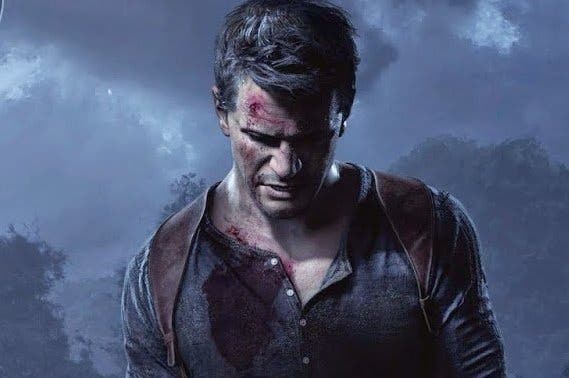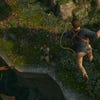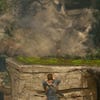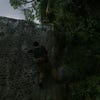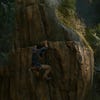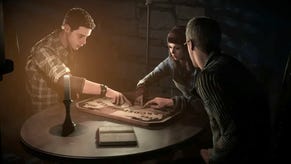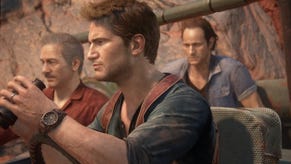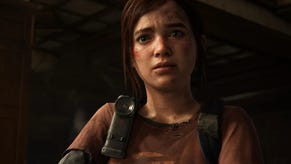Is Uncharted 4 the generational leap we were hoping for?
Digital Foundry presents its take on the 15-minute gameplay demo.
Gameplay reveals don't get much more exciting than this. This weekend's demonstration of Uncharted 4: A Thief's End gives us our first extended look at Naughty Dog's next-gen engine in playable conditions - and that's a big deal. After it was first teased at E3, the game was met with wild speculation and debate that would last for months over whether or not that level of visual fidelity could be achieved in real-time on current-gen console hardware. This brand new 15-minute gameplay demo helps to answer that question, while also giving us an idea of the kind of gameplay experience we might expect. Does the new footage stack up to the teaser trailer? Is this really a true next-generation Uncharted - or simply a prettier 1080p evolution of the existing formula?
The demo begins with a wide view of the jungle while the camera slowly pulls back to reveal Drake in his next-generation glory. However, it becomes immediately apparent that this isn't quite the same Drake we saw at E3 2014. While his facial structure appears comparable, the quality of his hair is reduced significantly while lighting and shading lack the sense of realism presented in the teaser, and the detail of his bandolier and shirt also seems pared back. Still, the transition from the initial cut-scene into gameplay is seamless, suggesting that the Drake we see here is at least the same model used during gameplay. The hair and shirt fabric also blow in the breeze, which looks quite nice in action, so while the overall impact seems to fall a little short of the teaser, Drake is still very nicely detailed here. He's also looking a bit younger - could this section be a flashback, perhaps, or simply at a point in the game before Drake really gets put through the wringer?
On a technical level, these early moments confirm that we're looking at a native 1080p presentation with some incredibly high quality anti-aliasing. It's not quite as clean as the near-flawless E3 teaser trailer but the results appear more impressive than just about any other solution we've seen on the platform to date. Edge-aliasing is all but eliminated, yet sharpness is retained while temporal aliasing (pixel pop and edge shimmer) is kept to a relative minimum. Some details, such as the skeletons early on, Drake's belt and some of the vines still show minor artefacting in motion but, overall, the solution Naughty Dog has adopted is looking really impressive. We're interested in learning more about this process - Sony shares its technology internally, so there's a strong chance we might see it deployed on other titles.
The next five minutes of the demo take the player on a tour of a small cave giving players a look at new traversal mechanics and their accompanying animations. We also get a peek at the updated water shaders, dynamic shadows and texture work. At first glance, traversal seems familiar but the animation has received a noticeable upgrade giving a bit more weight to Drake's motions. Furthermore, the tools he wears around his belt bounce around in a very realistic fashion in this revised engine. Almost immediately, Drake whips out his flashlight, revealing some dynamic shadows which appear perhaps a little too sharp for their own good, along with a bit of pixellation when examining the skeleton of a fallen explorer. At this point Uncharted looks strong and visually solid, but it doesn't really feel like a massive leap.
However, further on, Drake runs across a group of enemies - and it is here that the real changes and improvements start to become evident. It truly feels as if the team has learned a lot from creating The Last of Us, as the level design - from what we can tell - seems a lot more open than anything in previous Uncharted games. Drake is attacked from all angles on and around a series of rock formations. Taking a page from many of the best stealth action games, the level design seems to present open-ended design within a linear framework - that is, you're provided a large area filled with enemies and given the tools and skills necessary to eliminate them as you please. The verticality and fluidity is very much Uncharted but the freedom here seems more in line with something like Crysis or Metal Gear Solid 3. Of course, any demo can be made to look exciting, but it really seems as if we're looking at much more intricate level design here that is likely the product of more powerful hardware.
The bulk of the demo takes place along this cliff-side, where Drake takes out a number of enemies on his way through. This area is quite a bit more impressive than the initial cave sequence, with a deluge of reactive foliage blowing softly in the breeze, reacting to collisions with the player and enemy soldiers alike. It's a beautiful effect and one that seems to have real gameplay uses as well, with Drake able to stalk enemies from the brush. Foliage is drawn out remarkably far, retaining its reactive properties even at a great distance, but there are definitely some LOD issues that linger, with an ugly mesh effect used to fade detail in and out of the scene.
Still, as beautiful as the game's foliage is, the rock formations do leave a bit to be desired at this point. While texture work is impressive, we note many hard geometric edges visible across the world, reminiscent of Naughty Dog's work on the original Uncharted. We suspect that this is a compromise between aesthetics and gameplay - the developers need some way of highlighting traversable areas, otherwise the player could get lost. The trade-off is that these edges look almost artificially enhanced, literally standing out in a way that doesn't feel realistic. It's not helped by the fact that so many of these areas appear to lack proper occlusion properties, with bits and pieces fitting together without any sort of contact shadow.
Moving on, as a globetrotting adventure, we're certainly curious to see what other sort of locales the team has in store for us and how that translates into new materials throughout the game. At least this cliff-side level allows for some new and improved gameplay elements: the added traversal options seem to make navigating the environment more interesting and dynamic than anything in the series to date. With the addition of new climbing gear, reminiscent of 2013's Tomb Raider, Drake now has more options available for environment navigation. Rock faces are less defined by specific grab points and allow for more freeform climbing, while the new rope-swinging mechanics look like a lot of fun. Impressively, the rope deformation appears to be of exceptionally high quality - almost as if it were using tessellation of some sort.
The real clincher for this segment is the AI on display. Enemies appear to have free rein of the environment this time, jumping between various spires and actively working together. There is a real sense of cooperation in the demo that makes the scene appear much more dynamic than previous Uncharted combat sequences. The stealth gameplay seems to be a huge step up from previous titles as well, with Drake able to more effectively lose enemies only to re-engage on his own terms later. Of course, we don't want to get our hopes up after The Last of Us fell a bit short in comparison to the AI showcase in its initial gameplay demo, but there's definitely a lot of potential here. The more realistic Uncharted has become, the more Nathan Drake has come across as a wise-cracking sociopath leaving a trail of bodies in his wake. If that's the way the player wants to progress, that's fine, but there's the sense here that Naughty Dog is at least offering players the option of a non-lethal - or at least casualty-reduced - path through the game.
There are also improvements made to the enemies themselves. With the original Drake's Fortune it often felt as if you were killing clones of the same few pirates over and over again, but from what we can tell here, Naughty Dog has delivered greater enemy variety. There appear to be more base models with combinations of clothing varying between many of them, along with different voices, giving the impression that you are engaging different people as opposed to a stream of clones.
A number of other details help to create a more cohesive world. In one instance, we spotted smoke particles from a grenade properly receiving shadows from the world geometry. Particle shadows tend to be a rather demanding effect but really add to the realism when used properly. Alongside that, the debris kicked up by this explosion seems to bounce around the scene in a more realistic fashion. Drake's wetness properties also appear to be of higher precision this time, while dirt and mud more realistically sticks to the model in the appropriate spot. The only really disappointing omission here has to be the lack of per-object motion blur. This has been a staple of Naughty Dog's visual design since Uncharted 2 (though it was added in a patch to Uncharted 3 due to an omission on the gold master) so it's disappointing to see it absent in this sequence. Of course, it's still early and could be added at a later date, but without it, things don't quite look as nice in motion as we'd like.
More disappointing, however, is the frame-rate. Not long after E3 Naughty Dog confirmed that it was targeting 60fps for Uncharted 4 and, after making such a big deal about it for The Last of Us, we were hopeful that the team was making it the standard for its PS4 projects. Unfortunately, as confirmed in an official blog post, this new demo updates at a stable 30fps instead. It's not yet clear if this has become the game's new target, of course, but it's certainly disappointing after the flawless 60fps teaser (so was it real-time or not? We've still yet to see an on-the-record quote from the developer). However, the game has plenty of time left in development, so it's not impossible that Naughty Dog is still targeting 60fps - but we would like to see some clarification.
Overall, if this demo is any indication, we're actually looking at some pretty meaningful changes to the core gameplay due to more complex level design, improved AI, and a larger selection of tools. After our first viewing of the footage, Uncharted 4 definitely felt like an iterative evolution, but after re-watching several times, the improvements become clearer, suggesting a real leap forward for the series - but perhaps not quite to the extent hoped for in the areas we expected. The fact that Naughty Dog was able to deliver such an interesting combat sequence without resorting to any major set-pieces says a lot about what the studio is trying to achieve this time.
In a way, the demo flips our expectations somewhat. Naughty Dog may simply be keeping its powder dry for now, but the visuals seen in this gameplay segment aren't quite the jaw-dropping spectacle we had hoped for based on the immense promise of the E3 teaser. Clearly, the slice of gameplay seen here is very attractive, if a bit subdued overall. However, we are surprised by the large number of meaningful changes to the gameplay that the studio is showcasing in this segment. First impressions might suggest a visually upgraded 1080p Uncharted experience - something we would relish - but could it be that the real generational leap lies in how it plays?
